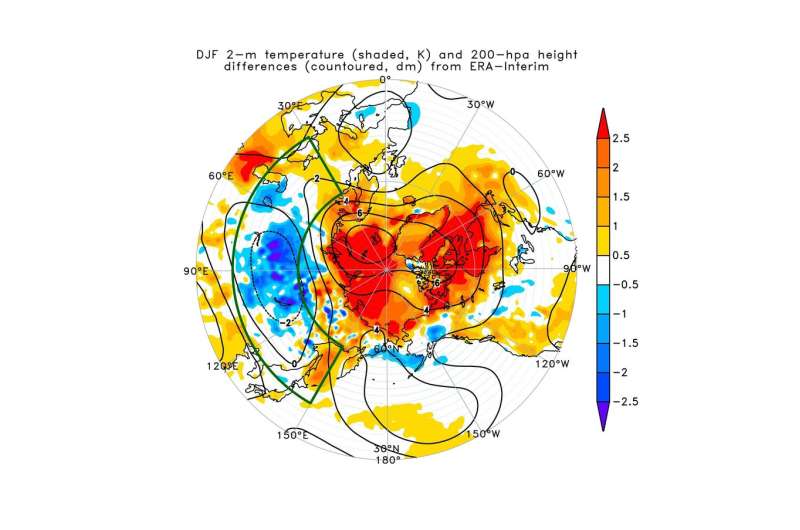Arctic sea ice loss and the Eurasian winter cooling trend: Is there a link?

Observations of Arctic sea ice have shown that it has been melting at a fast pace over the last few decades. However, what is more uncertain and presently a subject of debate is how these sea ice changes might be impacting weather patterns in non-Arctic regions. One particular topic of interest has been the recent cooling of winter temperatures (DJF: December through February) over the Eurasia region and whether or not sea ice loss is playing a role.
A recent study published in Advances in Atmospheric Sciences by scientists from INNOVIM and NOAA/NCEP Climate Prediction Center looks at atmospheric simulations of near-surface (2 m above ground level) temperatures from the National Centers for Environmental Prediction (NCEP) Climate Forecast System version 2 (CFSv2) model configured with different sea ice concentration (SIC) and sea surface temperature (SST) conditions. CFSv2 models the atmosphere component, not ocean parameters like sea ice or SST, which need to be prescribed (known as boundary conditions). They used SIC and SST from an early period (1981-1990), SIC1 and SST1, and a later period (2005-2014), SIC2 and SST2. In the later period, sea ice is reduced and SSTs are warmer than in the early period. The researchers explored whether the simulations with less sea ice or warmer SSTs produce the cooler temperatures seen over Eurasia in the last decade, or if they were a chaotic variation of the climate system that will eventually even itself out.
Paired differences of 100-year runs were carried out to analyze the influence of changing SST, SIC, and both parameters. For example, differences between SST2ICE2 and SST1ICE1 are considered to be to the result of both SST and SIC changes between the two 10-year periods, while differences between SST1ICE2 and SST1ICE1 are the result of impacts from SIC changes alone. None of the model configurations were able to produce the cooling that was seen over Eurasia.
"If we change both the sea ice and SSTs to the later period, we actually get a large amount of warming in the winter over Eurasia," the team reports. Most of this warming is seen when just SSTs are changed as well, with little role from sea ice changes in producing the warming.
Analysis of historical coupled (ocean and atmospheric variables are simulated) CFSv2 model simulations covering the same time periods shows that the expanse of Eurasian warming becomes larger with increasing leads. "Our results demonstrate that the recent cooler temperature trends may simply be a consequence of random, chaotic variability of the atmosphere, and a warming trend may eventually resume," the team concludes.
More information: Thomas W. Collow et al, Simulations of Eurasian winter temperature trends in coupled and uncoupled CFSv2, Advances in Atmospheric Sciences (2017).
Provided by Chinese Academy of Sciences



















